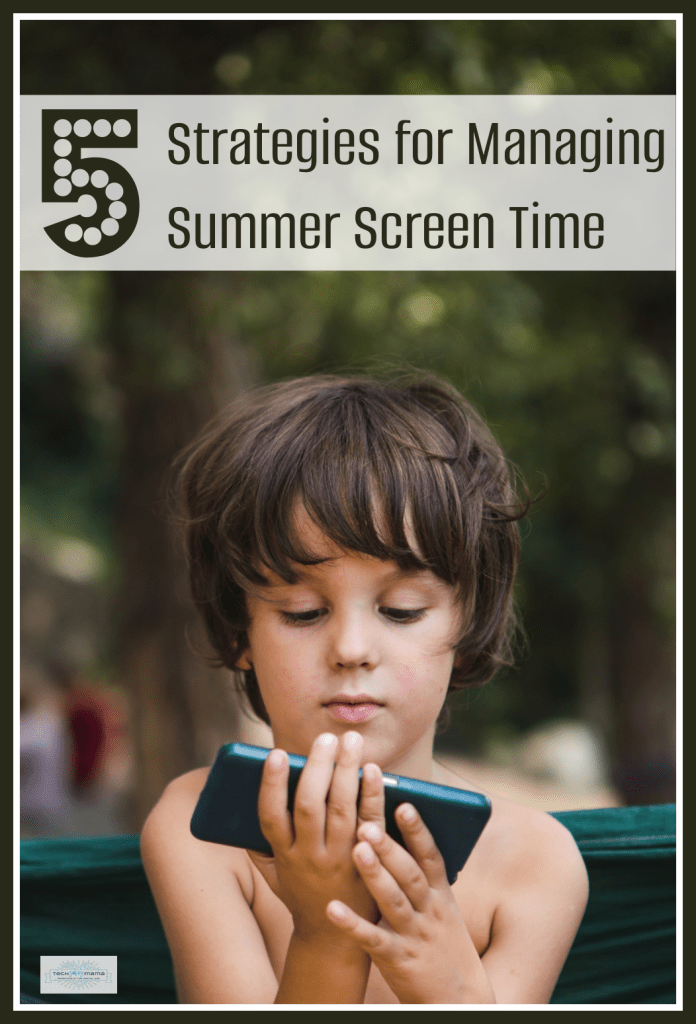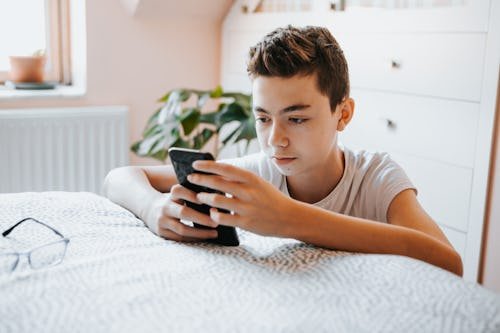
As school winds down and summer approaches, parents everywhere are gearing up for battles managing summer screen time. Summer days are unstructured compared to those during the school year and in between camps, time at the pool, vacations, and general relaxing, it can be a challenge to find a balance between unplugging and plugging in.
5 Strategies for Managing Summer Screen Time

Over the last couple weeks I’ve shared realistic strategies for managing summer screen time on local TV and radio stations that won’t leave you feeling defeated and your kids victorious. Here are some of the tips I’ve shared on-air to help you and your family manage screen time this summer.
Consider How You Manage Your Family’s Technology

Managing summer screen time is different for every family. Think about your current guidelines for screen time and how your family’s summer schedule might alter your kids’ screen time. Consider:
What works well for your family and your pain points
Chances are you don’t notice the things that are working well but you do notice where the problem areas are. Whether it’s keeping devices charged, staying within texting and data limits, disconnecting from devices before bedtime, or just spending too much time looking at their phones rather than connecting in real life, commend your kids for the things that they’re doing well then work with them to figure out how you can be better about the areas where you struggle.
Modeling the technology use you expect from your kids

Step back and assess how often you’re looking at your screens when your kids expect you to be present. As parents, we need to model what we expect for our kids by setting an example and looking away from our screens. Acknowledging your struggle to unplug goes a long way with your kids. They’re far more inclined to work with you on managing technology in your home when you admit your screen time faults too.
Your screen time expectations for summer days

What will be the expectations on days where your kids are free versus those where they have camp, swim team, etc.? Will you set a loose schedule even on days where you have no plans? What’s more important- limiting the number of minutes in front of a screen per day or highlighting other priorities before screen time?
Set priorities, rather than monitoring minutes

“We have a plan,” my neighbor of two boys gleefully proclaimed to me one summer when our kids were in elementary school. “Before screens, my kids need to make sure they’ve read and exercised.”
Setting such expectations are realistic and achievable for her sons. They also help ensure that the important stuff is done early in the day before screen time begins. Setting priorities for the day, instead of monitoring minutes, could be the secret to summer happiness thanks to less time spent nagging, pulling your hair out, and feeling guilty.
Helpful resource:
The American Academy of Pediatrics’ HealthyChildren.org’s Family Media Plan that helps families be aware of when you’re using media to achieve your purpose. HealthyChildren.org wants parents and users to think about the purposes of technology in the home and use the site as a resource to create goals & rules that align with your family’s values.
Seek Balance

As you consider a new strategy for managing summer screen time over the summer, it’s important to seek balance. An outright ban of technology in the home can be frustrating to every member of the family.
Helpful reads:
Arguments for and against limiting screen time:
- Don’t Limit Your Teen’s Screen Time on the New York Times
- Even Techies Limit Their Children’s Screen Time on NPR
Know the Difference Between Active and Passive Screen Time

Part of managing summer screen time is being able to distinguish between active and passive screen time. When kids are actively engaged, they’re learning through the content on the screen whereas passive screen time is all about consumption. As parents, it’s critical that we know the difference between the two and recognize when our kids are just consuming content versus using technology as a learning tool. It’s easy to see them on a screen and harp on then to get off when really, they might be learning a useful skill.
Helpful reads:
If you’re wanting to know more about the differences between active and passive screen time, these articles can help:
- Passive vs. Creative Screen Time on Tech Age Kids
- What You Need to Know About Babies, Toddlers and Screen Time on NPR
Search Out Ways Kids Can Learn Through Screens

Since not all screen time is equal, it’s up to us to help guide our kids towards age appropriate learning activities that they can do on mobile devices, tablets, and home computers. Technology can be helpful in fostering interests, developing background knowledge about a place you’re traveling to this summer, learning new skills, and preventing the dreaded summer slide through engaging interactive content but knowing where to find quality content is important.
Here are some age appropriate ways kids can use technology as a learning tool this summer.
Preschoolers
- Square Panda— Square Panda is a phonics based system designed for ages 2-8 uses teaches letters, syllables, sounds, and other reading fundamentals in fun ways thanks to smart letter manipulatives that turn your iPad into a learning tool. The learning games are engaging and provide positive feedback to keep the youngest ages motivated. With 14 levels of phonics instruction and a diagnostic engine that measures each child’s individual progress, challenges, preferences for game types, and patterns of play, Square Panda provides lots of learning for kids but useful information for parents and teachers to ensure that kids become confident fluent readers. For more information, read my past posts about Square Panda here.
Elementary Ages

- YouTube Kids— YouTube Kids is lifesaver for parents of kids ages 2-10 who are looking for just-right age appropriate videos, channels, and playlists. The easy to navigate app has a visual format that’s easy for the youngest kids to navigate and a safe experience so kids can easily find videos on topics they want to explore. YouTube Kids is available for free on Google Play and the App store in the U.S. and if you have a YouTube Premium subscription ($9.99/month) your YouTube Kids content is ad-free and can be watched offline.
- Minecraft– Yes, believe it or not this imaginary brick filled building world does have benefits because it fosters creativity, critical thinking and spatial skills.
Middle and High Schoolers
- Brainly— Middle and high schoolers who are juggling summer activities like work and camps while trying to prepare themselves for the year ahead can benefit from Brainly. Called an AI learning companion, Brainly doesn’t do the work of learning for older kids like other AI tools might. Instead, Brainly helps students keep up on their studies by providing 24/7 help via AI that’s verified by experts. Since we know your child’s teachers aren’t available in the summer to answer questions or provide additional learning, Brainly helps fill this gap for kids when they need homework help, a deeper dive into a subject, or even test prep assistance. In addition to real time help as it’s needed, Brainly also presents content in a visually engaging way that makes tweens and teens more inclined to study during the summer months.
Be Ok with More Screen Time from Time to Time

Just like we want our kids to be healthy eaters and attempt to balance each meal, sometimes it’s better to look at the overall picture of the day, rather than individual meals. The same is true for our kids’ media diet and screen time. It’s ok if you find yourself abandoning your own rules for managing summer screen time.
Chances are there are some days where your kids are busy from morning until late at night and their packed day doesn’t leave a lot of time for screen time. There might be other days that are pure down time. Or perhaps they spent the whole morning out in the hot sun and need to regroup in the air conditioned comfort of your house.

Instead of thinking about the number of minutes per day your kids spend in front of a screen, consider their screen time over the course of the week. Perhaps if there was very little screen time one day, it’s ok to have more the next day. Or maybe if your child was outside with friends all morning, invite those friends in to cool off and play video games or with a movie marathon.
When managing summer screen time, it’s important to find the balance that works well for your family and embrace it. After all, we parents have enough on our plates and shouldn’t always feel guilty about screens during the summer.
I am a member of the YouTube Kids Parent Panel and serve as Brainly’s Parenting Expert but was not compensated for including them in this post. All opinions are my own. Affiliate links may be included in this post.
The post 5 Strategies for Managing Summer Screen Time at Home appeared first on Tech Savvy Mama.







